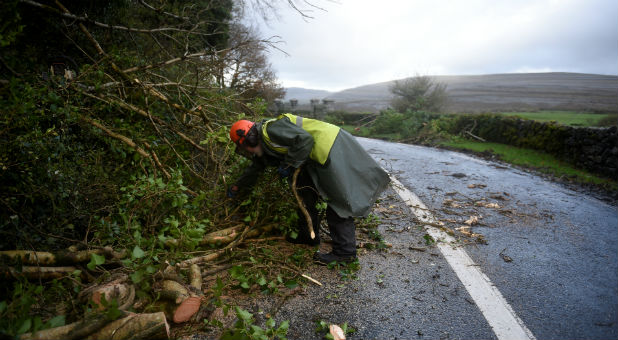3 Killed After Ophelia Battered Ireland
Three people died as Tropical Storm Ophelia battered every corner of Ireland on Monday, knocking down trees and power lines and whipping up 10-metre (30-foot) waves.
Over 330,000 homes and businesses were without electricity in the Republic of Ireland at 1915 GMT, down from an earlier peak of 370,000. Ireland’s Electricity Supply Board described it as an unprecedented event that would affect every part of the country for days.
About 200 flights from Ireland’s two main airports at Dublin and Shannon were cancelled. The airports will reopen on Tuesday as the cleanup begins.
Two people were killed in separate incidents when trees fell on their cars—a woman in her 50s in the southeast and a man on the east coast. Another man in his 30s died while trying to clear a fallen tree in an incident involving a chainsaw.
The storm, downgraded from a hurricane overnight, was the worst to hit Ireland in half a century. It made landfall after 10:40 a.m. (0940 GMT), the Irish National Meteorological Service said, with winds as strong as 190 kph (110 mph) hitting the most southerly tip of the country.
There was some flooding in the western city of Galway, but the storm-force winds were set to clear the rest of the country by midnight and conditions return to normal on Tuesday.
“There are still dangers out there but the cleanup has started in some areas and the job of getting the country back to work has begun,” the chairman of Ireland’s National Emergency Coordination Group, Sean Hogan, told a news conference.
The armed forces had earlier been sent to bolster flood defences, while public transport services and hospitals were closed. Schools in both Ireland and Northern Ireland will remain shut for a second day on Tuesday.
There were at least 5,000 “damage points” across the country, Hogan said, including hundreds of roads blocked by fallen trees. Photos on social media showed roofs flying off buildings, including at Cork City soccer club’s Turner’s Cross stadium where the roof of one stand had collapsed.
Most peopled heeded Prime Minister Leo Varadkar’s advice to stay indoors, with major cities remaining almost empty all day.
The storm was expected to move towards western Scotland overnight. It brought dust from the Sahara and smoke from wildfires in southern Europe that turned the sky over London an unusual shade of yellow.
British media were comparing Ophelia with the “Great Storm” of 1987, which subjected parts of the United Kingdom to hurricane-strength winds 30 years ago to the day.
The Irish government said the storm was likely to be the worst since Hurricane Debbie, which killed 11 in Ireland in 1961.
It passed close to a western Ireland golf course owned by U.S. President Donald Trump, who has been planning a wall to protect its greens from coastal erosion.
Similar storms in the past have changed the shape of stretches of the Irish coastline, climatologists said. {eoa}
© 2017 Thomson Reuters. All rights reserved.














































